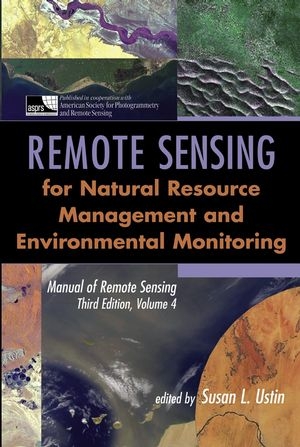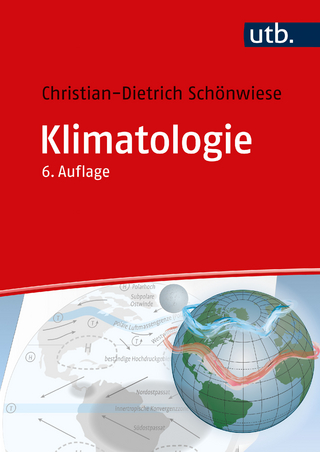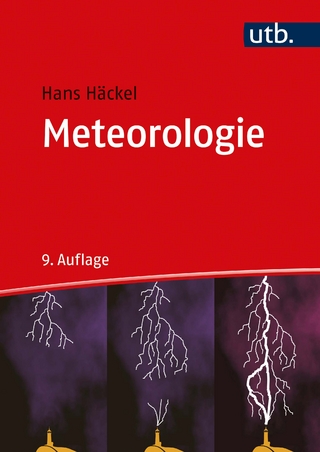
Manual of Remote Sensing
John Wiley & Sons Inc (Verlag)
978-0-471-31793-7 (ISBN)
- Titel ist leider vergriffen;
keine Neuauflage - Artikel merken
SUSAN L. USTIN, PhD, is Professor of Resource Science in the Department of Land, Air, and Water Resources at University of California, Davis. She is also Director of the Western Regional Center for Global Environmental Change (WESTGEC), and Director of the UCD California Space Institute Center of Excellence and the Center for Spatial Technologies and Remote Sensing (CSTARS), both at UC Davis.
Preface. Contributors. PART I: Remote Sensing of Terrestrial Ecosystems. CHAPTER 1: Remote Sensing of Soils and Soil Processes (Alfredo Huete). 1.1. Introduction. 1.2. Properties Controlling Soil Reflectance. 1.2.1 Biogeochemical Properties. 1.2.2 Optical-Geometric Interactions. 1.2.3 Soil Moisture. 1.3. Deriving Soil Properties at the Landscape Scale. 1.3.1 Direct Measurements. 1.3.2 Landscape Mixtures. 1.3.3 Inferring Soil Properties through Vegetation. 1.3.4 Optical-Geometric Variations. 1.4. Monitoring Soil Processes. 1.4.1 Land Cover and Land Use Change. 1.4.2 Soil Biogeochemistry. 1.4.3 Soil Moisture and Drought. 1.4.4 Soil Degradation Processes. 1.4.5 Soil Erosion Processes. 1.5. Soil Resource Databases. 1.6. Conclusions. References (see CD-ROM). CHAPTER 2: Biophysical Remote Sensing Signatures of Arid and Semiarid Ecosystems (Gregory P. Asner). 2.1 Introduction. 2.1.1 Land Use and Cover Change in Arid and Semiarid Regions. 2.1.2 Remote Sensing of Vegetation Cover and Condition. 2.1.3 Four Optical Remote Sensing Signature Domains. 2.2. Spatial Signatures. 2.2.1 Spatial Resolution. 2.2.2 Landscape Heterogeneity and Spatial Scale. 2.2.3 Landscape Texture. 2.2.4 Categorical and Continuous Fields of Land Cover. 2.2.5 Light Detection and Ranging. 2.3. Spectral Signatures. 2.3.1 Spectral Variability of Earth Surfaces. 2.3.2 Conceptual Model of Landscape Reflectance Variability. 2.3.3 Background Reflectance: Rocks, Soils, and Cryptobiotic Crusts. 2.3.4 Variability of Plant Tissue Optical Properties. 2.3.5 Variability of Canopy Tissue Content. 2.3.6 Variability of Canopy Tissue Orientation. 2.3.7 NPV Variability at Canopy Scales. 2.3.8 Relative Importance of Tissue, Canopy, and Landscape Characteristics. 2.3.9 Spectral Observations of Dryland Regions. 2.4. Angular Signatures. 2.4.1 Introduction and Terminology. 2.4.2 Measurements of Angular Reflectance Signatures. 2.4.3 Angular Signatures as Noise or Knowledge. 2.4.4 Employing Angular Signatures in Arid and Semiarid Regions. 2.5. Temporal Signatures. 2.5.1 Biophysical Change Detection. 2.5.2 Continuous Time Series. 2.5.3 Temporal Mixture Analysis. 2.5.4 Pitfalls and Caveats. 2.6. Thermal-Infrared Signatures. 2.6.1 Background. 2.6.2 Temperature Applications. 2.6.3 Emissivity Applications. 2.7. Fusion of Signature Domains. 2.8. Acknowledgments. References (see CD-ROM). CHAPTER 3: Remote Sensing in Arid Regions: Challenges and Opportunities (Gregory S. Okin and Dar A. Roberts). 3.1. Introduction. 3.2. Remote Sensing Applications in Desert Areas. 3.2.1 Remote Sensing of the Extent of the Sahara Desert. 3.2.2 Land Use, Land Cover, and Land Degradation. 3.2.3 Applications of Remote Sensing to Desert Geomorphology. 3.2.4 Atmospheric Remote Sensing in Arid Regions. 3.3. Remote Sensing Techniques in Deserts. 3.3.1 High-Resolution Remote Sensing. 3.3.2 Multispectral and Hyperspectral Remote Sensing. 3.3.3 Multitemporal Remote Sensing. 3.3.4 Radar and Microwave Remote Sensing. 3.4. Remote Sensing in Arid Regions: Challenges and Limitations. 3.4.1 Summary. 3.5. Case Study: Manix Basin, San Bernardino County, California. 3.5.1 Retrieval of Vegetation Information from Remote Sensing Imagery. 3.5.2 Summary: Land Degradation in the Manix Basin. 3.6. Conclusions. References (see CD-ROM). CHAPTER 4: Temperate and Boreal Forests (Eric S. Kasischke, Scott Goetz, Matthew C. Hansen, Mutlu Ozdogan, John Rogan, Susan L. Ustin, and Curtis E. Woodcock). 4.1. Introduction. 4.1.1 Temporal and Spatial Resolution and Sensor Choice. 4.2. Coarse-Resolution Optical Systems. 4.2.1 History of AVHRR and NDVI Monitoring. 4.2.2 Calibration and Validation Issues for AVHRR. 4.2.3 Mapping of Vegetation Cover and Characteristics. 4.2.4 Continuous Fields of Vegetation. 4.2.5 Monitoring and Mapping of Fires. 4.2.6 Monitoring and Mapping Other Large-Scale Disturbances. 4.3. High-Resolution Optical Systems. 4.3.1 Common Methods for Analysis of High-Resolution Data. 4.3.2 Forest Composition. 4.3.3 Forest Structure. 4.3.4 Forest Biophysics. 4.3.5 Forest Biochemistry. 4.3.6 Forest Health. 4.3.7 Monitoring Forest Change. 4.4. Microwave Remote Sensing Systems. 4.4.1 Origins of Microwave Signatures from Forested Landscapes. 4.4.2 Characteristics of Microwave Systems. 4.4.3 Land Cover Mapping. 4.4.4 Estimation of Aboveground Biomass. 4.4.5 Monitoring Soil and Vegetation Moisture Characteristics. 4.4.6 Monitoring Temperature-Related Effects. 4.5. New and Emerging Technologies. 4.5.1 Very High Spatial Resolution Data. 4.5.2 Lidar. References (see CD-ROM). CHAPTER 5: Tropical Forests (Richard M. Lucas, Alexander A. Held, Stuart R. Phinn, and Sassan Saatchi). 5.1. Introduction. 5.1.1 Tropical Forests: Past and Present. 5.1.2 Remote Sensing of Tropical Forests. 5.1.3 Chapter Outline. 5.2. Characteristics of Tropical Forests. 5.2.1 Definitions of Tropical Forests. 5.2.2 Importance of Tropical Forests. 5.3. Remote Sensing Instruments: Past and Present. 5.3.1 Importance of Spatial Resolution. 5.3.2 Temporal Resolution. 5.3.3 Exploiting the Electromagnetic Spectrum: Passive Sensors. 5.3.4 Exploiting the Electromagnetic Spectrum: Active Sensors. 5.4. Factors Complicating Remote Sensing of Tropical Forests. 5.4.1 Cloud Cover, Atmospheric Conditions, and Rainfall Events. 5.4.2 Forest Boundary Definition. 5.4.3 Subpixel Forest Cover. 5.5. Biophysical Properties. 5.5.1 Canopy Cover, Composition, and Dynamics. 5.5.2 Three-Dimensional Structure of Forests. 5.5.3 Biomass of Tropical Forests. 5.5.4 Leaf Characteristics. 5.5.5 Field Measurements. 5.6. Forests Condition. 5.6.1 Undisturbed Forests. 5.6.2 Disturbed Forests. 5.7. Forest Degradation. 5.7.1 Positive Feedbacks Leading to Degradation. 5.7.2 Indicators of Forest Degradation. 5.8. Forest Regeneration. 5.8.1 Reflectance Characteristics of Regenerating Forests. 5.8.2 Time-Series Data Sets for Discriminating and Mapping Regeneration Age and Pathway. 5.8.3 Land Use Impacts on Tropical Forest Regeneration. 5.8.4 Characterizing Regeneration Stage Using SAR Data. 5.9. Major Initiatives in Tropical Forest Remote Sensing. 5.9.1 Tropical Ecosystem Environment Observations by Satellite Project. 5.9.2 Global Rain Forest Mapping and Central African Mosaic Projects. 5.9.3 NASA Landsat Pathfinder Humid Tropical Forest Inventory Project. 5.9.4 Estimate of Amazon Gross Deforestation Project. 5.9.5 State of the Wet Tropics Region, Australia. 5.10. Future Sensors. 5.10.1 Forest Cover Characterization and Change. 5.10.2 Ecosystem Functioning and Biophysical Parameter Retrieval. 5.10.3 Forest Fire Monitoring and Mapping. 5.11. Conclusions. 5.12. Acknowledgments. References (see CD-ROM). PART II: Remote Sensing of Aquatic Ecosystems. CHAPTER 6: Tropical Freshwater Wetlands (John M. Melack). 6.1. Introduction. 6.2. Introduction to Synthetic Aperture Radar. 6.3. Applications of Remote Sensing Systems to Tropical Wetlands. 6.3.1 Multispectral Optical Sensors. 6.3.2 Microwave Sensors. 6.4. Validation. 6.5. Case Study: Central Amazon Basin. 6.5.1 Biogeochemical Applications of Remotely Sensed Data. 6.6. Acknowledgments. References (see CD-ROM). CHAPTER 7: Rivers and Lakes (Leal A. K. Mertes, Arnold G. Dekker, G. Robert Brakenridge, Charon M. Birkett, and Guy Letourneau 7.1. Introduction). 7.1.1 Rivers. 7.1.2 Lakes. 7.2. Remote Sensing Characteristics. 7.2.1 Water Quality from Optical and Near- Infrared Data. 7.2.2 Riparian Vegetation. 7.2.3 Hydrologic Water Properties. 7.3. Remote Sensing Applications. 7.3.1 Water Quality from Optical and Near-Infrared Data. 7.3.2 Riparian Vegetation. 7.3.3 Water Properties. 7.3.4 Topographic Mapping. 7.4. Case Studies. 7.4.1 Wetland Monitoring Program, St. Lawrence Centre, Environment Canada. 7.4.2 Inundation and Sediment Concentration Maps, Southeastern United States. 7.4.3 Chlorophyll Concentration Maps, Netherlands Lakes. 7.5. Acknowledgments. References (see CD-ROM). CHAPTER 8: Coastal Margins and Estuaries (Curtiss O. Davis, Gia M. Lamela, Timothy F. Donato, and Charles M. Bachmann). 8.1. Introduction. 8.1.1 Overview of Ocean Remote Sensing. 8.1.2 Applications of Remote Sensing to the Coastal Environment. 8.2. Coastal Wetlands. 8.2.1 Definition and Importance. 8.2.2 Identification and Classification. 8.2.3 Change Detection. 8.2.4 Productivity, Biogeochemical Cycling, and Global Climate Change. 8.3. Coastal Geomorphology. 8.3.1 Classification and Mapping. 8.3.2 Shorelines. 8.3.3 River Deltas. 8.3.4 Tidal Inlets. 8.4. Coastal Ocean. 8.4.1 Fisheries and Aquaculture. 8.4.2 Water Quality Assessment. 8.4.3 Harmful Algal Blooms. 8.4.4 Bottom Characteristics and Bathymetry. 8.4.5 Submerged Aquatic Vegetation and Coral Reefs. 8.5. SAR Observations of Coastal and Estuarine Waters. 8.6. Mapping Surface Salinity. 8.7. Coastal Ocean Dynamics. 8.8. Case Studies. 8.8.1 Mapping Coastal Ecosystems over a Steep Development Gradient Using CCAP Protocols. 8.8.2 Use of Landsat Thematic Mapper, Radarsat SAR, and High-Resolution HyMap Imagery. 8.8.3 Mapping of the Nile Delta. 8.8.4 LEO-15 Ocean Observatory. 8.9. Summary and Future Directions. References (see CD-ROM). PART III: Remote Sensing of Agriculture Ecosystems. CHAPTER 9: Grazing Agriculture: Managed Pasture, Grassland, and Rangeland (Michael J. Hill) 9.1. Introduction. 9.1.1 Definition of Managed Grassland. 9.1.2 Distribution. 9.1.3 Physical Characteristics. 9.1.4 Animal Populations and Production. 9.2. Issues for Livestock and Grassland Management. 9.2.1 Managed Grasslands as Ecosystems. 9.2.2 Production. 9.2.3 Sustainability. 9.2.4 Greenhouse Impacts. 9.2.5 Intensification and Overproduction. 9.2.6 Economic Feasibility of Livestock Enterprises. 9.2.7 Benchmarking: Paddock-to-Product Systems. 9.2.8 Precision or Site-Specific Management. 9.3. Critical Characteristics of Managed Grassland Systems in Relation to Remote Sensing. 9.3.1 Scale. 9.3.2 Spatial Variation. 9.3.3 Mobility of the Production Unit (the Animal). 9.3.4 Temporal Variation, Seasonality, and Phenology. 9.3.5 Importance of Chemical Composition. 9.3.6 Methods to Address These Issues. 9.4. Remote Sensing Technology and Methodology for Managed Grasslands. 9.4.1 Imaging Resolution. 9.4.2 Multiangle Imaging. 9.4.3 Imaging Spectrometry. 9.4.4 Spectral Reflectance Models. 9.4.5 Synthetic Aperture Radar. 9.4.6 Laser Altimetry or Lidar. 9.4.7 Multitemporal Multispectral Imaging. 9.4.8 Red-Edge Analysis. 9.4.9 Fluorescence. 9.5. Critical Targets for Remote Sensing of Managed Grasslands. 9.5.1 Land Cover, Condition, and Change. 9.5.2 Leaf Area Index. 9.5.3 Canopy Structure and Bidirectional Reflectance Distribution Function. 9.5.4 Biomass. 9.5.5 Plant Litter and Senescent Vegetation. 9.5.6 Canopy Temperature-Water Status. 9.5.7 Botanical Composition. 9.5.8 Growth and Net Primary Production. 9.5.9 Grazing Impacts and Animal Production. 9.5.10 Erosion and Land Degradation. 9.5.11 Chemical Constituents. 9.5.12 Nutrient Status. 9.5.13 Insects. 9.5.14 Weeds, Pests, and Diseases. 9.6. Remote Sensing and Systems Models for Managed Grasslands. 9.7. Remote Sensing of Animals. 9.7.1 Identification. 9.7.2 Tracking Location and Welfare. 9.7.3 Monitoring. 9.8. Conclusions. 9.9. Acknowledgments. References (see CD-ROM). Suggested Reading (see CD-ROM). CHAPTER 10: Remote Sensing of Dryland Crops (Jerry L. Hatfield, John H. Prueger, and William P. Kustas). 10.1. Introduction. 10.2. Vegetative and Reproductive Growth. 10.2.1 Vegetative Indexes. 10.2.2 Comparisons of Vegetative Indexes. 10.2.3 Leaf Area Index. 10.2.4 Crop Biomass. 10.2.5 Intercepted Radiation. 10.2.6 Crop Ground Cover. 10.2.7 Crop Yield. 10.2.8 Confounding Factors. 10.3. Application of Remote Sensing to Dryland Cropping Systems. 10.4. Acknowledgments. References (see CD-ROM). CHAPTER 11: Wetland Agriculture (Sushma Panigrahy and K. R. Manjunath). 11.1. Introduction. 11.2. Rice-Growing Systems. 11.2.1 Lowland Rice. 11.2.2 Deepwater Rice. 11.2.3 Floating Rice. 11.2.4 Components of Wetland Rice Production. 11.3. Rice Crop. 11.3.1 Morphology and Growth Stages. 11.3.2 Growing Season and Crop Calendar. 11.4. Remote Sensing Studies: Optical Region. 11.4.1 Ground-Based Observations. 11.4.2 Studies Using Airborne Sensors. 11.4.3 Studies from Spaceborne Data. 11.4.4 Constraints of Optical Remote Sensing. 11.5. Remote Sensing Studies: Microwave Region. 11.5.1 Signatures in the Microwave Region. 11.5.2 Classification. 11.6. Rice Crop Monitoring Using SAR Data. 11.6.1 Progress of Planting and Crop Calendar. 11.6.2 Flood and Drought. 11.7. Biophysical Parameter Retrieval. 11.8. Operational Rice Monitoring Experience. 11.8.1 SAR-Based Rice Forecasting Program. 11.9. Other Wetland Crops. 11.9.1 Taro. 11.9.2 Jute. 11.10. Wetland Systems and Global Warming. 11.11. Emerging Trends. 11.11.1 Integrated Approach Toward Best Practice in Crop Monitoring. 11.11.2 Cropping Systems Analysis. 11.11.3 Precision Crop Management. References (see CD-ROM). CHAPTER 12: Application of Image-Based Remote Sensing to Irrigated Agriculture (M. Susan Moran, Stephen J. Maas, Vern C. Vanderbilt, Edward M. Barnes, Scott N. Miller, and Thomas R. Clarke). 12.1. Introduction. 12.2. Background. 12.2.1 Crop Water Stress and TIR Wavelengths. 12.2.2 Crop Water Stress and Visible, NIR, SWIR, and SAR Wavelengths. 12.2.3 Optical Properties of Plant Leaves. 12.2.4 Optical Properties of Plant Canopies. 12.3. Remotely Sensed Information for Management of Irrigated Agriculture. 12.3.1 Irrigation and Water Information. 12.3.2 Nutrient Application. 12.3.3 Weed Scouting and Herbicide Application. 12.3.4 Insect Scouting and Insecticide Application. 12.3.5 Crop Yield. 12.3.6 Soil Characterization. 12.3.7 Next-Season Preparation. 12.4. Conclusions. 12.5. Acknowledgments. References (see CD-ROM). PART IV: New Directions. CHAPTER 13: Remote Sensing of the Environment: State of the Science and New Directions (Susan L. Ustin, Stephane Jacquemoud, Pablo J. Zarco-Tejada, and Gregory P. Asner). 13.1. Introduction. 13.2. Global Biogeochemical Cycles. 13.2.1 Measuring and Monitoring Feedback between the Biosphere and the Atmosphere. 13.2.2 Land Cover Characterization. 13.2.3 Land Use Conversion and Change. 13.2.4 Summary. 13.3. Estimation of Canopy Biochemistry. 13.3.1 Methods for Leaf Biochemical Estimates. 13.3.2 Scaling-up Methods for Canopy Biochemical Estimates. 13.3.3 Summary. 13.4. Estimation of Canopy Biophysical Properties. 13.4.1 Estimating Leaf Area Index and Net Primary Productivity. 13.4.2 Improvement of LAI and fPAR Estimations by Using Multiangular Data. 13.4.3 Derivation of New Parameters. 13.4.4 Image Validation. 13.4.5 Summary. 13.5. Conclusions. References (see CD-ROM). Index.
| Erscheint lt. Verlag | 28.5.2004 |
|---|---|
| Reihe/Serie | Manual of Remote Sensing ; BD 4 | 1.20 |
| Verlagsort | New York |
| Sprache | englisch |
| Maße | 179 x 260 mm |
| Gewicht | 1508 g |
| Themenwelt | Naturwissenschaften ► Geowissenschaften ► Allgemeines / Lexika |
| Naturwissenschaften ► Geowissenschaften ► Geografie / Kartografie | |
| Technik | |
| ISBN-10 | 0-471-31793-4 / 0471317934 |
| ISBN-13 | 978-0-471-31793-7 / 9780471317937 |
| Zustand | Neuware |
| Informationen gemäß Produktsicherheitsverordnung (GPSR) | |
| Haben Sie eine Frage zum Produkt? |
aus dem Bereich


